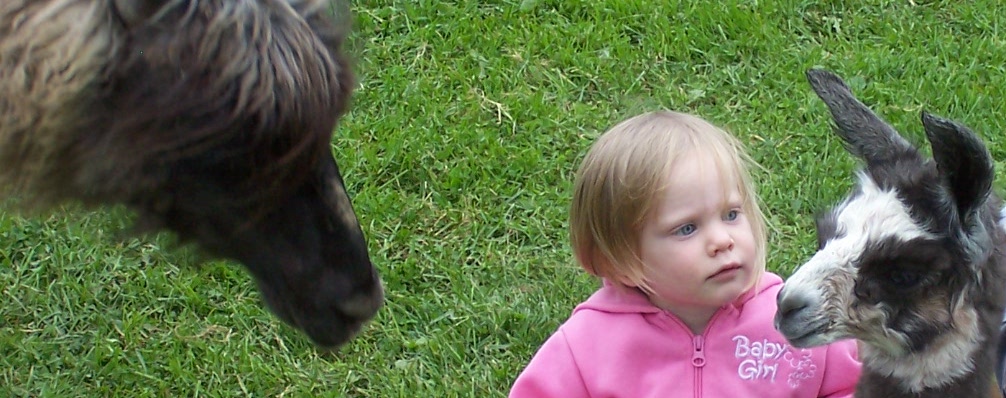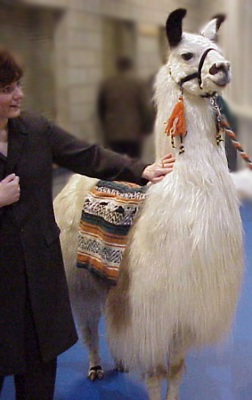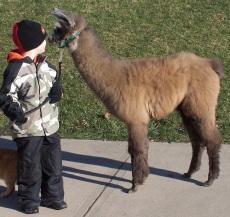| ..Leisure Acres Llamas | llamas
for sale in PA * male llamas * female llamas guard llamas * llama breeding service * llama info |

Llama Basics: Facts, Figures, and Basic Information
Here are some of the things prospective owners
need to know about these fascinating animals
|
Weight: Adult llamas can weigh from 250 to 450 pounds. Llamas weigh about 25 pounds at birth. Color: Llamas boast a mind-boggling array of patterns and solid colors, ranging from snowy white to jet black and everything in between - the full gamut of grays, tans, beiges, and rusty brownish reds. Disposition: Llamas tend to be docile, curious, non-aggressive, and quietly compatible. They're highly social and will always be happiest when they're part of a herd; though llamas have been known to bond with other animals, such as sheep or goats, they really thrive with the companionship of other llamas and will do best in groups or at least pairs. Life Span: A llama's normal life span is 15 to 25 years. Intelligence: Llamas are highly intelligent animals and learn quickly. Because they're also calm and curious, they're very trainable and can master many skills. Overall Health Picture: Excellent. Llamas are hardy and generally healthy animals that are disease-resistant and don't require a great deal of special handling. Routine vaccinations and worming are generally the only medical care required to keep llamas in good health. However, llamas are uncomplaining animals and tend to hide illnesses or problems, so it's important to get to know your llamas and keep an eye out for distressed or unusual behavior
Housing Requirements: Llamas are not demanding about housing - all they really need is uninterrupted access to shelter for protection from extremes of hot, cold, or wet weather, plus good fencing. Many llama owners have successfully "improvised" llama living arrangements using existing barns and buildings. Reproduction: Female llamas are usually fertile by the age of two and can be bred at any time of year. Baby llamas (known as crias) are born after a long (350 day) gestation period, usually one at a time - twins are rare. An interesting llama fact: crias are almost always born during daylight hours. Experts believe this is a built-in safety measure of particular value to llamas in their original habitat, ensuring that the new baby is up and moving by the time darkness falls and night predators arrive. The cria will depend on its mother's milk for four to six months before being weaned.
|
|
Llamas For Sale
More Llama Info Articles ...• Llama Facts...• Llamas At Work ...• Is a Llama Right For You? ...• Good Things About Llamas ...• Select The Right Llama ...• Ten Tips For New Owners
|
 Height:
A full-grown llama stands three to four feet at the
shoulder and five to six and a half feet tall at the head.
Height:
A full-grown llama stands three to four feet at the
shoulder and five to six and a half feet tall at the head. Food
Requirements: Llamas are modified ruminants;they
have a single segmented stomach and like cows, they chew cud
(partially digested food). Good pasturage and high quality hay
are crucial to the llama diet, but because they have a relatively
low requirement for protein, a wide variety of pasturages can
suit their needs. Sometimes additional vitamins, minerals, and
salt are needed and ready-made llama supplements are available.
Feeding llamas can be much more affordable than feeding other
animals of similar size.
Food
Requirements: Llamas are modified ruminants;they
have a single segmented stomach and like cows, they chew cud
(partially digested food). Good pasturage and high quality hay
are crucial to the llama diet, but because they have a relatively
low requirement for protein, a wide variety of pasturages can
suit their needs. Sometimes additional vitamins, minerals, and
salt are needed and ready-made llama supplements are available.
Feeding llamas can be much more affordable than feeding other
animals of similar size.

